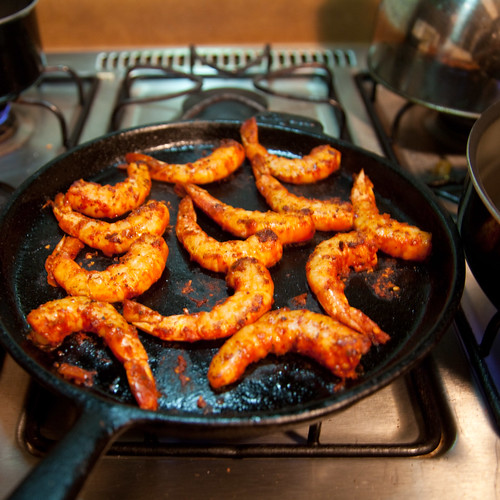There are a couple of approaches to this pork dish. The meat can first be simmered barely covered with water for a couple of hours until very tender and then, after the water is boiled off, the meat is fried in it's own rendered fat until crispy. There are also recipes where the meat is poached in lard, and finally there are some where the meat is firstly braised until cooked and then the final crisping is done in the oven.
The last two methods don't appeal to me much, I find the idea of turning on the oven for something that has already been slow cooked wasteful, and while poaching the meat in lard sounds succulent, it's also messy and in all likelihood pretty unhealthy.
Ignoring the various ways of getting there, the destination for me is a succulent and slightly crispy pork dish that is scented with bay and orange. The orange is what makes the dish distinctive for me, though it seems to be omitted in quite a few recipes. It's also the combination of both crispy and tender that makes the dish really great.
The dish takes some time, though there is very little actual preparation time. The dish bubbles away unattended for the vast majority of the cooking time and requires little attention accept during the final frying.
Preparation
About a pound and a half of pork, ideally shoulder, cut into one inch or larger cubes is placed in a singe layer in a large saucepan or casserole. Water is added to cover, along with a heaped tablespoon of lard, half of a tennis ball sized onion thinly sliced, four cloves of garlic, half of an orange cut into four pieces, a couple of bay leaves, oregano, salt and pepper.
The meat is brought to a boil and then then kept at a low simmer, covered, for a couple of hours.
When ready to finish the dish the cover is removed and the heat is increased. Pretty soon the available water will evaporate and the sound will change from one of liquid bubbling to frying. The meat is then fried in the lard and it's own rendered fat until the desired crispiness is achieved. Personally I like some texture but dislike the meat being too dry and find ten minutes or so to be sufficient. I also like to break the chunks of pork into smaller pieces.
Carnitas are generally used as a taco filling, accompanied by corriander and onion and some salsa the quantity above is sufficient to provide enough meat for a meal of tacos for three to four people. I have seen carnitas described as a menace to public health, and it's amazing the way the meat can soak up all of the rendered fat and added lard. Perhaps they are best enjoyed as an occasional treat rather then the cornerstone of a diet!
Monday 24 October 2011
Wednesday 19 October 2011
Chintextle de Oaxaca
There appear to be a couple of versions of this Oaxacan paste, the version I made from the Roberto Santibanez book is a paste of pumpkin seed and dried chile, however looking on-line there are also versions of the sauce which include dried shimp as part of the paste.
The procedure is simple and consists of the following blended together (in a food processor as the paste is too thick to be made in a blender):
3/4 of a cup of toasted pumpkin seeds
About 10 toasted dried chiles
Garlic
A tablespoons of cider vinegar and another of rice wine vinegar
Enough olive oil to form the paste
Salt
I tried this a number of times using both pasilla and guajillo chiles and also using chiles which had been soaked in water after toasting. The recipe in the book calls for Passilla de Oaxaca chiles which are hotter and smokier than regular passila chiles, but which I have never been able to find in the shops. The paste is quite thick and I think requires more than the tablespoon of oil that Santibanez suggests to achieve the right consistency.
The paste works well with chicken and is also a good addition to the tortilla for a quesadilla, though it benefits from a days resting for the flavours to mellow.
The procedure is simple and consists of the following blended together (in a food processor as the paste is too thick to be made in a blender):
3/4 of a cup of toasted pumpkin seeds
About 10 toasted dried chiles
Garlic
A tablespoons of cider vinegar and another of rice wine vinegar
Enough olive oil to form the paste
Salt
I tried this a number of times using both pasilla and guajillo chiles and also using chiles which had been soaked in water after toasting. The recipe in the book calls for Passilla de Oaxaca chiles which are hotter and smokier than regular passila chiles, but which I have never been able to find in the shops. The paste is quite thick and I think requires more than the tablespoon of oil that Santibanez suggests to achieve the right consistency.
The paste works well with chicken and is also a good addition to the tortilla for a quesadilla, though it benefits from a days resting for the flavours to mellow.
Subscribe to:
Posts (Atom)
